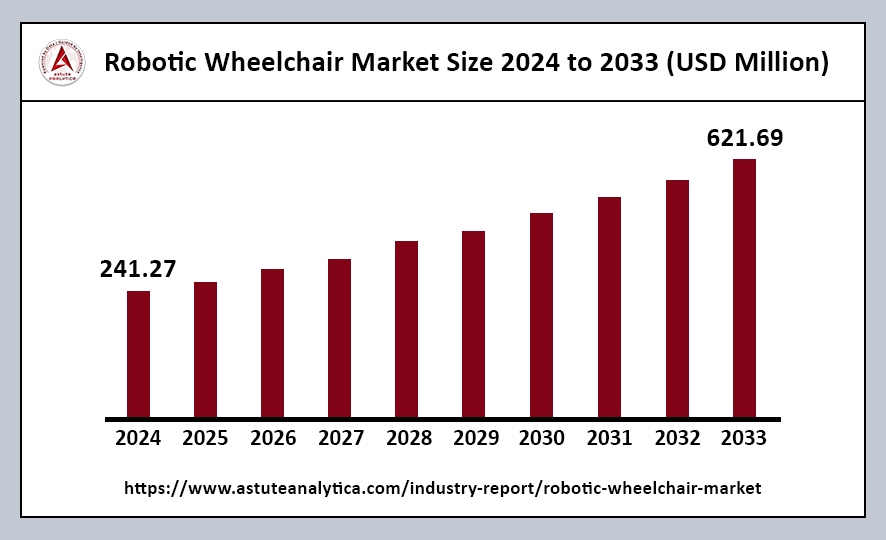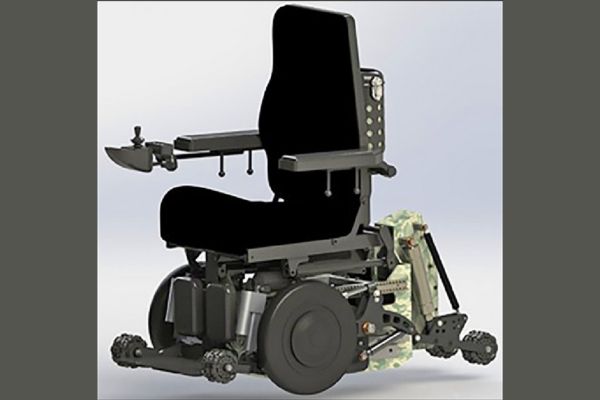The global robotic wheelchair market was valued at US$ 241.27 million in 2024 and is projected to reach US$ 621.69 million by 2033, reflecting a Compound Annual Growth Rate (CAGR) of 12.56% during the forecast period from 2025 to 2033.

Robotic wheelchairs are undergoing rapid evolution, fueled by advancements in artificial intelligence and sensor integration that are redefining independent mobility. Demographic trends, including the growing aging population and rising rates of mobility impairments due to chronic conditions, are contributing to the increased demand for these innovative solutions. As more individuals seek options that provide mobility assistance and technological convenience, the market is expanding to meet these evolving needs.
Robotic Wheelchair Market Key Takeaways
- By Product Type, powered models hold over 55% of the global robotic wheelchair market share.
- Joystick-controlled wheelchairs account for approximately 45% of the revenue in the robotic wheelchair market.
- A significant portion of the robotic wheelchair market is dominated by homecare settings and individual consumers, capturing more than 40% of the overall market share.
- In terms of application, indoor mobility assistance has emerged as a standout segment in the robotic wheelchair market, accounting for over 39% of total industry sales globally.
Regional Analysis
Influence of North America on the Global Robotic Wheelchair Market
North America exerts a powerful influence over the global robotic wheelchair market, capturing more than 35% of total sales.
- Strong Healthcare Infrastructure: One of the primary reasons for North America’s dominance in the robotic wheelchair market is its strong healthcare infrastructure. This infrastructure supports the development, distribution, and integration of sophisticated mobility solutions, making advanced robotic wheelchairs widely available to those in need.
- Large Disabled Population: A key contributor to North America’s leadership in this market is the sizable disabled population within the region. This demographic creates an unwavering demand for sophisticated mobility solutions. The United States alone is home to tens of millions of individuals with mobility impairments, leading to a consistent need for state-of-the-art equipment.
- Government Support and Insurance Reimbursement: Government programs and private insurance providers play a crucial role in driving the adoption of robotic wheelchairs. Many of these programs reimburse a substantial portion of the cost associated with advanced wheelchairs, making them more affordable for consumers.
- Financial Incentives for Investment: In addition to insurance reimbursement, financial incentives such as tax deductions for home medical equipment motivate many families to invest in robotic options. These incentives make it economically feasible for users to opt for advanced mobility solutions, enhancing their quality of life and independence.
Growth in the European Robotic Wheelchair Market
The European robotic wheelchair market is witnessing significant growth and is expected to maintain this momentum over the forecast period.
- Advanced Features of Robotic Wheelchairs: Robotic wheelchairs are equipped with advanced features that enhance usability and safety for users. Key functionalities include obstacle avoidance, navigation assistance, and ergonomic designs specifically tailored to meet the needs of older users. These features improve the user experience and ensure they can navigate their environments safely and comfortably.
- Increasing Awareness and Acceptance: There is a growing awareness and acceptance of innovative healthcare solutions in Europe. As governments recognize the importance of assistive technologies, they are implementing policies and funding programs that support the development and distribution of robotic wheelchairs, making them more accessible to those in need.
- Advancements in Robotics and AI Technologies: Robotics and AI technologies have significantly improved the reliability and user-friendliness of robotic wheelchairs. These technological innovations enhance the performance of the devices, allowing for smoother navigation and more intuitive controls.
Fastest Growth in Asia Pacific
The Asia Pacific region is projected to witness the fastest compound annual growth rate (CAGR) over the forecast period.
- Increasing Per Capita Income: One of the primary drivers behind this growth is the rise in per capita income in emerging nations within Asia Pacific. As consumers gain increased financial capacity, they are more willing to invest in healthcare solutions that enhance their quality of life.
- Growing Elderly Population: The region is also experiencing a notable increase in the elderly population, which is creating a heightened demand for mobility solutions. As the number of seniors rises, there is a corresponding need for assistive technologies, including robotic wheelchairs, to support their mobility and independence.
- Expanding Healthcare Industry: The rapidly expanding healthcare industry in the Asia Pacific is another factor driving the demand for the robotic wheelchair market. As healthcare infrastructure improves and more advanced medical technologies become available, the accessibility of mobility aids, such as robotic wheelchairs, increases.
- Rising Incidence of Disabilities: The rising incidence of disabilities due to chronic diseases, accidents, and age-related issues further contributes to market growth. As more individuals face mobility challenges from these conditions, the demand for effective mobility solutions intensifies.
Top Trends Escalating the Robotic Wheelchair Market
Voice-Activated Interfaces: Voice-activated interfaces are revolutionizing user interaction by providing instinctive control feedback. This technology allows users to operate their wheelchairs through simple voice commands, making navigation more accessible, especially for individuals with limited dexterity. This intuitive interaction model significantly reduces the learning curve, making it easier for users to adapt to their devices in various environments.
Augmented Reality Overlays: Augmented reality overlays enrich spatial awareness during dynamic maneuvering operations. Users can visualize their surroundings in real time, which is particularly beneficial in complex environments such as crowded spaces or narrow hallways. This enhanced spatial awareness improves safety and empowers users to navigate more confidently and efficiently.
Integrated Biometric Feedback Systems: Integrated biometric feedback systems significantly boost real-time contextual adaptation capabilities. These systems monitor various physiological parameters, such as heart rate, muscle tension, and posture, allowing the wheelchair to adjust its performance dynamically based on the user’s physical condition. This level of adaptability enhances user comfort and safety, providing a more personalized experience.
Revolutionary AI Integration: The integration of revolutionary AI drives autonomous navigation, transforming advancements in robotic mobility. AI algorithms enable wheelchairs to learn from their environments and user habits, allowing them to navigate independently. This technology enhances mobility for users and empowers them to engage more fully in their daily activities without constant manual input.
Innovative Sensor Fusion and Machine Learning: Innovative sensor fusion and machine learning enhance wheelchair user responsiveness. By combining data from multiple sensors—such as cameras, LIDAR, and accelerometers—these systems create a comprehensive understanding of the environment. This responsiveness is crucial for ensuring user safety and comfort, particularly in dynamic settings.
Advanced Data Analytics: Finally, advanced data analytics streamline adaptive control systems, optimizing user mobility. This results in a more efficient and enjoyable experience for the user, as the wheelchair can adjust to provide the best possible assistance in real time. The integration of data analytics not only enhances the performance of the wheelchair but also contributes to ongoing improvements in design and functionality.
Robotic Wheelchair Market Segmentation
By Product Type
In the rapidly evolving market for assistive technologies, it is notable that over 55% of global robotic wheelchair market sales are attributed to powered models, reflecting a surge in consumer preference for enhanced mobility functionalities. The underlying driver behind this trend is the heightened focus on user comfort, safety, and independence, particularly for seniors and individuals with severe mobility impairments.
By Control Mechanism
Joystick-controlled wheelchairs account for around 45% of robotic wheelchair market revenue due to their intuitive interface and minimal learning curve. Many users, including those with moderate dexterity issues, find joystick navigation far more approachable than Brain-Computer Interface (BCI) or gesture-based systems, which often require complex calibration. A joystick’s smooth directional control and adjustable sensitivity cater to a wide range of mobility levels, making it the go-to solution for day-to-day use.
By End Users
A substantial contingent of homecare settings and individual consumers has risen to the forefront of the robotic wheelchair market, capturing more than 40% of the overall market share. This surge in this demographic stems from a heightened desire for independence among people with mobility challenges, who often wish to manage daily tasks in familiar surroundings. Smart design features—such as chairs that smoothly pivot through narrow hallways and glide easily over carpets—cater to domestic environments.
By Application
Indoor mobility assistance has emerged as a standout application in the robotic wheelchair market, accounting for over 39% of industry sales worldwide. The rising demand for accessible solutions that streamline daily routines—such as navigating one’s home, heading to local shops, or keeping up with medical visits—has established this segment as a core driver of market growth.
Recent Developments in the Robotic Wheelchair Market
- Nintendo’s Switch 2 Mouse Capabilities: In April 2025, Nintendo showcased the Switch 2’s mouse capabilities through an exciting 3-on-3 basketball game that resembles Rocket League, but with the twist of featuring robot wheelchairs.
- Innovative Exoskeleton Wheelchair in Thailand: In March 2025, Thailand’s Chulalongkorn University unveiled the Exoskeleton Wheelchair, a groundbreaking robotic suit designed to assist individuals with disabilities. This innovative technology enables users to stand, walk, and move more independently. The project was led by an Associate. Prof. Dr. Ronnapee Chaichaowarat from the Faculty of Engineering, focuses on enhancing mobility beyond traditional wheelchairs.
- Development of CoNav Smart Wheelchair: In February 2025, researchers at the University of Michigan developed CoNav, a smart wheelchair that operates using a Robot Operating System (ROS) based framework, marking a significant advancement in wheelchair technology.
Top Players in the Robotic Wheelchair Market:
- Permobil
- Honda Motor Co., Ltd.
- Toyota Industries Corporation
- Whill, Inc.
- Karman Healthcare
- iMerciv
- Mobius Mobility
- UBTECH Robotics
- Harmonic Bionics, Inc.
- Sunrise Medical LLC
- MEYRA GmbH
- Matia Robotics, Inc.
- Other Prominent Players
Market Segmentation Overview:
By Product Type
- Smart Robotic Wheelchairs
- Powered Robotic Wheelchairs
- Hybrid Robotic Wheelchairs
By Control Mechanism
- Joystick-Controlled
- Brain-Computer Interface (BCI)
- Gesture-Controlled
- Voice-Controlled
- Mobile-App Controlled
By Application
- Indoor Mobility
- Outdoor Mobility
- Rehabilitation
- Personal Mobility Assistance
By End Users
- Hospitals & Healthcare Facilities
- Homecare Settings/ Individuals
- Rehabilitation Centers
- Elderly Care Facilities
- Defense & Military
By Distribution Channel
- Offline Retailers
- Online Channels
By Geography
- North America
- Europe
- Asia-Pacific
- Latin America
- Middle East and Africa
Source: https://www.astuteanalytica.com/industry-report/robotic-wheelchair-market

















